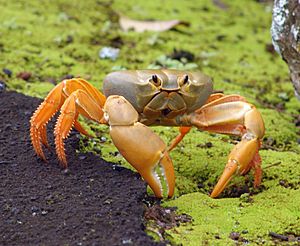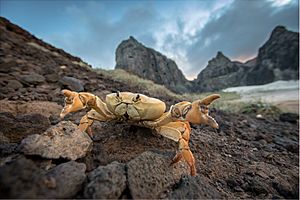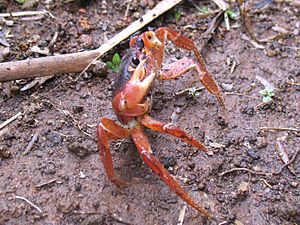Johngarthia lagostoma facts for kids
Quick facts for kids Johngarthia lagostoma |
|
|---|---|
 |
|
| Yellow morph of J. lagostoma | |
 |
|
| Porto Seguro, Trinidad | |
| Scientific classification | |
| Kingdom: | |
| Phylum: | |
| Subphylum: | |
| Class: | |
| Order: | |
| Infraorder: | |
| Family: |
Gecarcinidae
|
| Genus: |
Johngarthia
|
| Species: |
J. lagostoma
|
| Binomial name | |
| Johngarthia lagostoma (H. Milne-Edwards, 1837)
|
|
| Synonyms | |
|
Gecarcinus lagostoma H. Milne-Edwards, 1837 |
|
Johngarthia lagostoma is a type of terrestrial crab, meaning it lives mostly on land. This amazing crab makes its home on Ascension Island and three other islands in the South Atlantic. It can grow quite large, with its shell (called a carapace) reaching up to 110 millimeters (about 4.3 inches) wide on Ascension Island. There, it's the biggest native land animal!
These crabs come in two main colors: bright yellow and dark purple. You don't often see crabs that are a mix of both. On Ascension Island, the yellow crabs are more common. However, on Rocas Atoll, you'll find more purple ones. Scientists can tell Johngarthia lagostoma apart from other crabs in its family by the unique shape of its third maxilliped (a mouthpart).
Johngarthia lagostoma crabs live in burrows, which are like underground homes, among plants. They can be found at heights of up to 400 meters (about 1,300 feet). They usually come out at night to find food. Their diet mainly consists of plants, but they sometimes eat small animals too. Every year, from January to March, these crabs make a journey to the sea. They do this to release their tiny, planktonic larvae into the ocean. The species was first described in 1837 by a scientist named Henri Milne-Edwards.
Contents
Where Do These Crabs Live?
Johngarthia lagostoma crabs are found on a few specific islands: Ascension Island, Trindade Island, Fernando de Noronha, and the Rocas Atoll.
On Ascension Island, these crabs mostly live on the slopes of Green Mountain. This area has enough moisture and plants for them to survive. The rest of the island is too dry for them. Any land above 400 meters (about 1,300 feet) is good habitat. Much of the land above 200 meters (about 650 feet) is also suitable. Sometimes, they are seen at lower places, like the well-watered gardens in Georgetown. They also appear near the sooty tern bird colony in the island's southwest.
On Trindade Island, J. lagostoma crabs are very common wherever plants grow. This includes the highest parts of the island. It's quite unusual for a species to be spread across such a small number of islands in the southern Atlantic Ocean. Scientists wonder how they managed to travel between these distant places.
What Do J. lagostoma Crabs Look Like?
Adult J. lagostoma crabs on Ascension Island typically have a carapace (shell) that is 70 to 110 millimeters (about 2.7 to 4.3 inches) wide. Crabs from the Rocas Atoll are a bit smaller.
These crabs are special because they have two distinct color forms. The "yellow" crab has a bright yellow or orange shell. It also has white patches on the underside of its walking legs and claws. The "purple" crab has a dark purple shell, but it also has the same white patches as the yellow ones. You might occasionally see a crab that is mostly yellow but has some purple spots on its shell.
On Ascension Island, the yellow crabs are seen more often. However, on the Rocas Atoll, there's a more even mix of yellow and purple crabs. Scientists think that darker crabs might be better at hiding from predators. But they might also get too hot during long journeys. The Rocas Atoll is much smaller than Ascension Island, so the crabs' travel routes are shorter there. This might explain why the different colors are found in different amounts on the islands.
Life in the Wild and Protecting Them
Before Europeans settled Ascension Island in the 1800s, Johngarthia lagostoma was the only large land animal there. Since then, many other animals like mice, rats, and rabbits have been brought to the island. These new animals now compete with the crabs for food and space.
J. lagostoma crabs are most active at night and after it rains. This is when they come out of their burrows, which can be up to 1 meter (about 3 feet) deep. They mostly eat plants, but they can also eat small animals. For example, in areas where sooty terns nest, the crabs sometimes eat the birds' chicks and eggs. They also prey on green sea turtle hatchlings when they emerge from their nests in May. Other animals like the Ascension frigatebird and feral cats also hunt these turtle hatchlings. The crabs find water on and under rocks, especially at night when cool surfaces collect moisture.
In the late 1800s, people on Ascension Island actually offered a reward to reduce the number of these crabs. Hunters were paid for every hundred claws they collected. In one year, over 80,000 land crabs were caught! Over eight years, more than 330,000 crabs were taken. Today, the crab population is much smaller. Scientists are concerned because there aren't many young crabs joining the population. This suggests the species might become endangered in the future.
The Crab's Life Cycle
Even though adult J. lagostoma crabs live almost entirely on land, their babies (called larvae) live in the ocean as tiny plankton. Because of this, the adult crabs must travel to the sea to release their offspring. This is similar to what other land crabs do, like the Christmas Island red crab.
For most crabs in this family, this journey happens during the rainy season. This helps keep them from drying out. For J. lagostoma, the migration happens from January to March. The heaviest rainfall, however, is from March to May.
The crabs can travel about 450 meters (about 1,476 feet) per day. Mating can happen anywhere along their journey to the sea. The female crabs carry their eggs, which are larger than those of other crabs in their family. This means they have fewer eggs. A female crab with a shell width of 94 millimeters (about 3.7 inches) might have around 72,000 eggs. The female crabs release their eggs into the sea during the last part of the lunar cycle, when the tides are not very strong. This usually happens on rocky shores.
How J. lagostoma Got Its Name
Johngarthia lagostoma was first described by Henri Milne-Edwards in 1837. He originally named it Gecarcinus lagostoma. The name lagostoma comes from Greek words meaning "hare-lip." This refers to a small split in the crab's mouthparts. Milne-Edwards mistakenly thought the crab came from "Australasia." However, the crabs he studied were actually collected from Ascension Island in 1829 by naturalists Jean René Constant Quoy and Joseph Paul Gaimard during a trip on the French ship Astrolabe.
Later, in 1970, a scientist named Michael Türkay placed G. lagostoma into a new group called Johngarthia. In 1987, he made Johngarthia a full genus.
Many famous explorers and scientists who visited Ascension Island commented on these land crabs. These included William Dampier, Charles Darwin, and Charles Wyville Thomson. One scientist, Bernard Stonehouse, described them as "disagreeable rather than sinister." He said they were shy and would quickly scuttle into their burrows if alarmed. He also noted their "frowning" mouthparts, which made them look unhappy.
Crabs from the islands in the Gulf of Guinea were once thought to be the same species as Johngarthia lagostoma. However, they are now considered a separate species called Johngarthia weileri.
Images for kids
See also
 In Spanish: Johngarthia lagostoma para niños
In Spanish: Johngarthia lagostoma para niños




